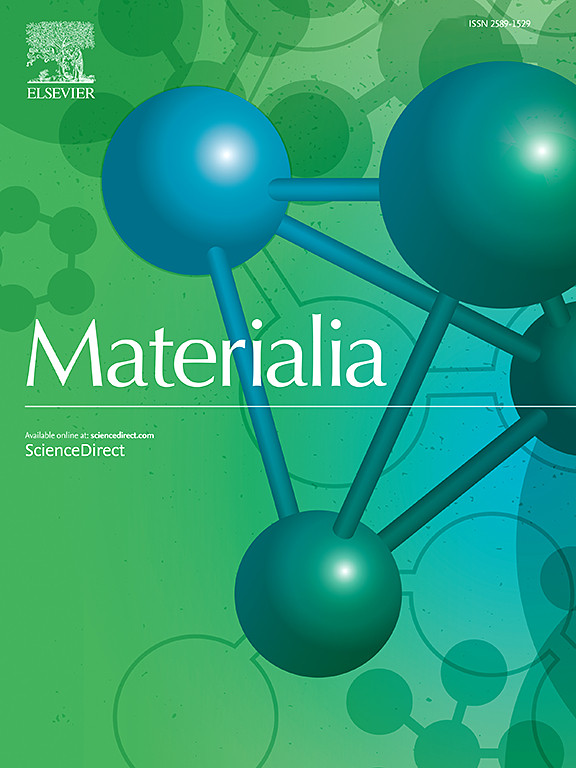AISI D2工具钢经标准和改性深冷处理后的组织和力学性能
IF 3
Q2 MATERIALS SCIENCE, MULTIDISCIPLINARY
引用次数: 0
摘要
本研究探讨了循环深冷处理(CDCT)对AISI D2冷作工具钢的潜在好处,重点是硬度和断裂韧性的增强及其与组织变化的相关性。虽然传统的- 196°C深度低温处理(DCT)已经证明对工具钢性能有积极影响,但DCT特定的长时间持续时间仍然是工业应用的限制。AISI D2钢试样分别在- 196℃下进行常规热处理和深度低温处理(DCT),并在相同温度范围内进行2、5、10次循环的深度低温处理(DCT)。利用SEM-EDS、EBSD、XRD和TEM等先进表征技术,对这些处理引起的显微组织演变、相变、残余应力、硬度和断裂韧性进行了全面分析。宏观和微观硬度测量采用洛氏和维氏方法进行,而断裂韧性评估采用周向缺口和疲劳预裂拉伸棒试样。结果表明,所有样品均具有相似的体硬度值。然而,CDCT显著提高了断裂韧性,其中CDCT2处理的提高幅度最大,比常规处理提高了68%。显微组织分析表明,纳米孪晶、层错、位错、小次生碳化物数量的增加、纳米碳化物析出量的增加以及较低的残余应力是提高力学性能的关键因素。本文章由计算机程序翻译,如有差异,请以英文原文为准。

Microstructure and mechanical performance of AISI D2 tool steel after standard and modified deep cryogenic treatment
This research investigates the potential benefits of cyclic deep cryogenic treatment (CDCT) on AISI D2 cold-work tool steel, focusing on hardness and fracture toughness enhancement and their correlation with structural changes. While conventional deep cryogenic treatment (DCT) at −196 °C has demonstrated positive effects on tool steel properties, the specific long durations of DCT remain a limitation for industrial applications. AISI D2 steel specimens underwent conventional heat treatment and deep cryogenic treatment (DCT) at −196 °C for 24 hours, alongside CDCT with 2, 5, and 10 cycles within the same temperature range. The microstructural evolution, phase transformations, residual stresses, hardness, and fracture toughness induced by these treatments were thoroughly analyzed using advanced characterization techniques, including SEM-EDS, EBSD, XRD, and TEM. Macro- and micro-hardness measurements were conducted using Rockwell and Vickers methods, while fracture toughness was assessed using circumferentially notched and fatigue-pre-cracked tensile bar specimens. The results indicate that all samples exhibited comparable bulk hardness values. However, fracture toughness showed significant enhancement with CDCT, with the CDCT2 treatment achieving the highest improvement—68 % greater than that of the conventional treatment. Microstructural analysis reveals refined martensitic structures with nanotwins, stacking faults, dislocations, an enhanced count of small secondary carbides, increased precipitation of nanosized carbides, and lower residual stresses as key contributors to the enhanced mechanical properties.
求助全文
通过发布文献求助,成功后即可免费获取论文全文。
去求助
来源期刊

Materialia
MATERIALS SCIENCE, MULTIDISCIPLINARY-
CiteScore
6.40
自引率
2.90%
发文量
345
审稿时长
36 days
期刊介绍:
Materialia is a multidisciplinary journal of materials science and engineering that publishes original peer-reviewed research articles. Articles in Materialia advance the understanding of the relationship between processing, structure, property, and function of materials.
Materialia publishes full-length research articles, review articles, and letters (short communications). In addition to receiving direct submissions, Materialia also accepts transfers from Acta Materialia, Inc. partner journals. Materialia offers authors the choice to publish on an open access model (with author fee), or on a subscription model (with no author fee).
 求助内容:
求助内容: 应助结果提醒方式:
应助结果提醒方式:


